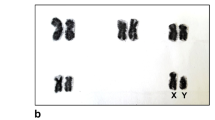Abstract
This work represents the first attempt to define tardigrade chromosomes using banding techniques. Macrobiotus richtersi, a eutardigrade morphospecies with amphimictic diploid and thelytokous triploid cytotypes, was used as a model. Prime consideration was given to oocyte chromosomes because they are larger than those of spermatocytes and of mitotic chromosomes. With Giemsa staining, the chromatids of the 6 bivalents of the diploid cytotypes and those of the 17–18 univalents of the triploid cytotypes were very similar to each other and appeared rod- or flame-shaped. In the amphimictic strain, a chiasma was generally present in each bivalent at diplotene, whereas there were no chiasmata in the oocyte prophase chromosomes of the triploid strain. Both in diploid and triploid cytotypes, C-banding and fluorescence showed a heterochromatic centromeric band on the telomere of each chromosome oriented towards the spindle pole, indicating that all of them were acrocentric. Silver staining showed the presence of a NOR in only a pair of chromosomes, close to the centromeric C-banded site. NOR was particularly evident in the oocyte prophases. Other silver positive regions, corresponding to the kinetochore, were located on all other chromosomes on the telomeres towards the spindle pole.
Similar content being viewed by others
References
Badaeva ED, Friebe B, Zoshchuk SA, Zelenin AV, Gill BS (1998) Molecular cytogenetic analysis of tetraploid and hexaploid Aegilops crassa. Chromosome Res 6: 629-637.
Bertolani R (1970) Mitosi somatiche e costanza cellulare numerica nei Tardigradi. Atti Accad Naz Lincei Rend Ser 8a 48: 739-742.
Bertolani R (1971) Partenogenesi geografica triploide in un Tardigrado (Macrobiotus richtersi). Atti Accad Naz Lincei Rend Ser 8a 50: 487-489.
Bertolani R (1975) Cytology and systematics in Tardigrada. Mem Ist Ital Idrobiol 32 Suppl: 17-35.
Bertolani R (1982) Cytology and reproductive mechanisms in tardigrades. In: Nelson DR, ed. Proceedings of the Third International Symposium on Tardigrada. Johnson City: East Tennessee State University Press, pp 93-114.
Bertolani R (1994) Tardigrada. In: Adiyodi KG, Adiyodi RG, eds. Reproductive Biology of Invertebrates. Asexual Propagation and Reproductive Strategies. Vol. VI, Part B. New Delhi, Oxford & IBH Publishing Co, pp 25-37.
Bertolani R, Garagna S, Manicardi GC, Redi CA (1987) Macrobiotus pseudohufelandi Iharos as a model for cytotaxonomic study in populations of eutardigrades. Experientia 43: 210-213.
Bertolani R, Garagna S, Manicardi GC, Rebecchi L, Redi CA (1994) New data on the nuclear DNA content in some species of tardigrades. In: Argano A, Cirotto C, Grassi Milano E, Mastrolia L, eds. Contributions to Animal Biology. Palermo: Halocynthia, pp 103-109.
Gall JP, Pardue ML (1971) Nucleic acid hybridization in cytological preparations. Meth Enzymol 479: 470-480.
Garagna S, Rebecchi L, Guidi A (1996) Genome size variation in Tardigrada. Zool J Linn Soc 116: 115-121.
Henneke J (1911) Beitra¨ ge zur Kenntnis der Biologie und Anatomie der Tardigraden (Macrobiotus macronyx Duj.). Z Wiss Zool 97: 721-752.
Howell WM, Black DA (1980) Controlled silver-staining of nucleolus organizer regions with a protective colloidal developer: a 1-step method. Experientia 36: 1014-1015.
Imai HT, Maruyama T, Gojobori T, Inoue Y, Crozier RH (1986) Theoretical bases for karyotype evolution. I. The minimum-interaction hypothesis. Am Nat 128: 900-920.
Imai HT, Takahata N, Maruyama T et al.. (1988) Theoretical bases for karyotype evolution. II. The fusion burst in man and mouse. Jpn J Genet 63: 313-342.
Lorite P, Ara´ nega AE, Luque F, Palomeque T (1997) Analysis of the nucleolar organizing regions in the ant Tapinoma nigerrimum (Hymenoptera, Formicidae). Heredity 78: 578-582.
Martínez-Expósito MJ, Méndez J, Pasantes JJ (1997) Analysis of NORs, NOR-associated heterochromatin in the mussel Mytilus galloprovincialis Lmk. Chromosome Res 5: 268-273.
Rebecchi L (1991) Karyological analysis on Macrobiotus pseudohufelandi (Tardigrada, Macrobiotidae) and a new finding of a tetraploid population. Caryologia 44: 301-307.
Redi CA, Garagna S (1987) Cytochemical evaluation of the nuclear DNA content as a tool for taxonomical studies in eutardigrades. In: Bertolani R. ed. Biology of Tardigrades. Selected Symposia and Monogaphs, UZI. Vol 1. Modena: Mucchi, pp 73-80.
Redi CA, Garagna S, Zuccotti M (1990) Robertsonian chromosome formation and fixation: the genomic scenario. Biol J Linn Soc 41: 235-255.
Ruiz IRG, De Almeida TMB, Becak W (1984) Active nucleolar organizer-regions in polyploid populations of Odontophrynus americanus (Amphibia, Anura) from South Brasil. Genetica 63: 31-37.
Schweizer D (1976) Reverse fluorescent chromosome banding with chromomycin and DAPI. Chromosoma 58: 307-324.
Sumner AT (1972) A simple technique for demonstrating centromeric heterochromatin. Exp Cell Res 75: 304-306.
von Wenck W (1914) Entwicklungsgeschichtliche Untersuchungen an Tardigraden (Macrobiotus lacustris Duj.). Jahrb Abt Anat 37: 465-514.
White MJD (1973) Animals Cytology and Evolution. Cambridge University Press.
Author information
Authors and Affiliations
Rights and permissions
About this article
Cite this article
Rebecchi, L., Altiero, T. & Bertolani, R. Banding techniques on tardigrade chromosomes: the karyotype of Macrobiotus richtersi (Eutardigrada, Macrobiotidae). Chromosome Res 10, 437–443 (2002). https://doi.org/10.1023/A:1020949228862
Issue Date:
DOI: https://doi.org/10.1023/A:1020949228862




